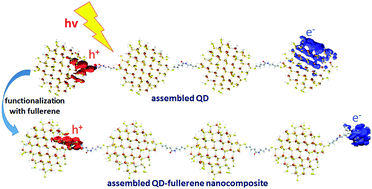Periodically-ordered one and two dimensional CdTe QD superstructures: a path forward in photovoltaics†
Abstract
By using the state-of-the-art theoretical method, we herein explore the potentiality of covalently linked periodically-ordered 1D chain, 2D hexagonal and square ordered superstructures of CdTe QDs in photovoltaics. One of the major factors that controls the photovoltaic efficiency is the electron–hole recombination which in turn depends on the spatial separation of these charge carriers. Our theoretical findings show that the HOMO and LUMO states are localized at two different ends of the assembled superstructures. This result indicates large spatial separation of photoexcited charge carriers which prolongs the carrier lifetime and thus reduces the chance of electron–hole recombination. We have also attached an acceptor fullerene molecule with the CdTe QD superstructure and studied the electronic structure of the composite system. The photoexcited electrons of the assembled QDs potentially transfer to the low energy lying conduction band of fullerene and show a large spatial charge separation. The assembled QD–fullerene composites exhibit a high photoconversion efficiency of 19.3%, opening up new possibilities for designing efficient solar energy harvesting devices based on assembled QDs.



 Please wait while we load your content...
Please wait while we load your content...